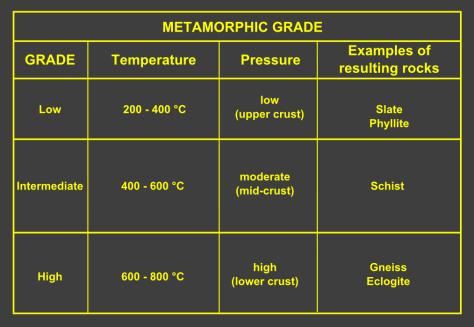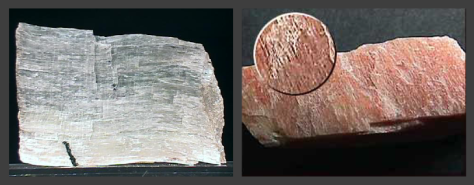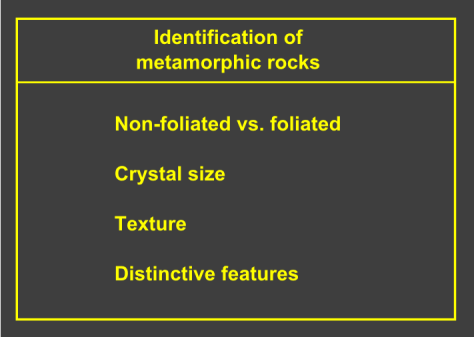As it usually goes in geology, nothing is forever, everything changes. In a process called metamorphism (“change in form”), old rocks are forcefully changed into a new, metamorphic rock. Since we’re talking about rocks, the change would be a transformation of a rock’s mineralogy and physical characteristics. The heat (temperatures over 150 to 200 °C) and pressure (1500 bars) cause profound physical and/or chemical change in the original rock – protolith. The protolith may be sedimentary, igneous or another older metamorphic rock.
The final metamorphic rock depends both on conditions of metamorphism and protolith composition. If the same protolith experiences different conditions of temperature and pressure, it will yield different metamorphic rocks.

Under high temperatures, basalt turns into greenschist, but under high pressures, it turns into eclogite.
If different protoliths experience the same conditions of temperature and pressure, they will also yield different metamorphic rocks.

A large part of the Earth’s crust is made up of metamorphic rocks. They’re classified by texture, chemical and mineral composition (metamorphic facies). They may be formed:
- simply by being deep beneath the Earth’s surface, subjected to high temperatures and great pressure of the rock layers above;
- from tectonic processes such as continental collisions, which cause horizontal pressures, friction and distortion;
- when the rock is heated by the intrusion of hot magma from the Earth’s interior.
Actual melting of the rocks is rarely involved. Instead, minerals recrystallize, i.e. their atoms reorganize into new minerals. When metamorphism strikes, not all minerals can be formed. Only those that form under high temperatures and pressures make out a metamorphic rock, such as sillimanite, kyanite, staurolite, andalusite and garnet. These minerals are known as index minerals.
Other minerals may also be found in metamorphic rocks, but not necessarily as a result of metamorphism. These minerals are formed during the crystallization of igneous rocks, they are stable at high temperatures and pressures and may remain chemically unchanged during the metamorphic process. The presence of some of these minerals in metamorphic rocks indicates the conditions (approximate temperatures and pressures) at which they formed.
When you learn about metamorphic rocks and how they form, you’ll often come across a process called recrystallization. It is a change in the size of particles that make out the rock, which occurs during metamorphism. For example, the small calcite crystals in limestone and chalk (sedimentary rocks) change into larger crystals in the metamorphic rock marble. High temperatures allow the atoms and ions in solid crystals to migrate, while high pressures cause solution of the crystals within the rock at their point of contact. This way both high temperatures and pressures contribute to recrystallization.
The identity of new minerals that form during metamorphism reveals the rock’s metamorphic grade – the amount of metamorphism it has experienced.

Index minerals are used to identify the metamorphic grade. The process starts with a clay-rich protolith., i.e. shale or mudstone.

At low grade of metamorphism muscovite and chlorite appear.

Chlorite & Muscovite
At medium grade biotite, garnet and staurolite appear, whereas chlorite disappears.

Biotite, garnet & staurolite
Kyanite appears at higher grade, whereas muscovite disappears.

Kyanite
At very high grade sillimanite and alkali feldspar appear and biotite, staurolite and kyanite disappear.

Sillimanite & alkali feldspar
There are a few types of metamorphism, different from one another by the way the temperature and pressure influence the protolith, most common of them being contact and regional metamorphism.
Contact (thermal) metamorphism evolves locally, when rocks near igneous intrusion get heated. This process produces non-foliated metamorphic rocks.
Regional metamorphism affects a large area, commonly due to mountain building. Foliated rocks appear and strong pressure effects can be seen on them.
In a case of differential pressure being a major cause of metamorphism, crystals of new platy minerals tend to align themselves perpendicular to the primary direction of pressure. The result is foliation – a rock texture that looks like leaves of a book.

Strong foliation/lineation in metavolcanic rock – the alignment of the long axis of mineral grains can be easily seen.

Now that we know all this, we can try to identify a metamorphic rock by texture and composition.

We can also connect the knowledge of foliation and metamorphic grades:
All in all, when we look at a metamorphic rock and want to identify it, we can help ourselves by using a simple set of steps:
Why are these metamorphic rocks so important?
Here are some of the most common metamorphic rocks and their uses in our everyday lives.
Slate
Before its metamorphosis under the surface of Earth, slate used to be shale. It is valued as a roofing material, decorative gardening stone, a base for snooker tables and was used as a writing board (or writing slate) in the Victorian classrooms.

Marble
Marble is metamorphosed limestone. It is a hard crystalline rock that has many uses. Approximately 22.000 tones of marble were used to build the Parthenon and its statues in ancient Greece, and it is still used as a building and sculpture material today. Marble can also be ground down and used in soaps and cleaning products.

Schist
Schist is formed from shale or mud but at a much higher temperature than slate. It is not a very strong rock so is not often used as a building material, but for garden decoration, paving and sometimes sculptures.

Learn more about other two major groups of rocks – igneous & sedimentary!


Reblogged this on PalaeoMud and commented:
Nice article on metamorphism in rocks.
I have self studied geology for years, collecting rocks all across North America. This is the best article I have ever read on the subject. Thank You!
Thanks, this is easy to understand.